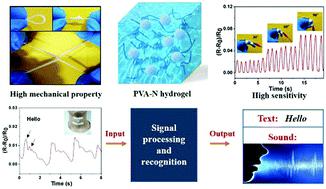当前位置:
X-MOL 学术
›
Mater. Chem. Front.
›
论文详情
Our official English website, www.x-mol.net, welcomes your
feedback! (Note: you will need to create a separate account there.)
High-performance ionic conductive poly(vinyl alcohol) hydrogels for flexible strain sensors based on a universal soaking strategy
Materials Chemistry Frontiers ( IF 6.0 ) Pub Date : 2020-09-29 , DOI: 10.1039/d0qm00625d Xiang Di 1, 2, 3, 4, 5 , Qiyue Ma 1, 2, 3, 4, 5 , Yue Xu 1, 2, 3, 4, 5 , Mingming Yang 1, 2, 3, 4, 5 , Guolin Wu 1, 2, 3, 4, 5 , Pingchuan Sun 1, 2, 3, 4, 5
Materials Chemistry Frontiers ( IF 6.0 ) Pub Date : 2020-09-29 , DOI: 10.1039/d0qm00625d Xiang Di 1, 2, 3, 4, 5 , Qiyue Ma 1, 2, 3, 4, 5 , Yue Xu 1, 2, 3, 4, 5 , Mingming Yang 1, 2, 3, 4, 5 , Guolin Wu 1, 2, 3, 4, 5 , Pingchuan Sun 1, 2, 3, 4, 5
Affiliation

|
Conductive materials with predominant mechanical properties and high sensitivity have promising applications in various fields such as fabrication of electric skins, wearable sensors, and soft robotics. High-performance and flexible strain sensors based on conductive hydrogels have attracted significant attention because of their potential applications in voice recognition and human–machine interfaces. Inspired by the mechanism of neural tissue signal transmission, herein, a high-strength and relatively high-sensitivity ionic conductive hydrogel was developed by utilizing the completely physically crosslinked polyvinyl alcohol (PVA) and a simple inorganic salt solution soaking strategy. The ionic conductive hydrogels exhibited intriguing remoldability and excellent mechanical properties such as superb tensile strength (8.03 MPa), high toughness (28.7 MJ m−3), and high elastic modulus (1 MPa) because of their high-density hydrogen bonding and chain entanglement networks. By integrating the PVA–NaCl gel into a flexible strain sensor, the sensor displayed high conductivity (7.14 S m−1) at room temperature and subzero temperature, high accuracy (GF = 0.989), and sensitive strain responsiveness in a wide strain detection window of 0.2–400%. These results imply good performance for monitoring and distinguishing various human daily activities and slight physiological signals. Furthermore, the as-made PVA sol could convert to gel state just by being injected on a flexible substrate under an ice-bath and the conductive hydrogels displayed excellent biocompatibility and improved cell proliferation. Therefore, the as-formulated hydrogel sensor can have promising applications in wearable devices, such as sports monitoring, healthcare monitoring or voice recognition.
中文翻译:

基于通用浸泡策略的用于柔性应变传感器的高性能离子导电性聚乙烯醇水凝胶
具有优越的机械性能和高灵敏度的导电材料在各种领域中都有着广阔的应用前景,例如电表皮,可穿戴传感器和软机器人的制造。基于导电水凝胶的高性能且灵活的应变传感器因其在语音识别和人机界面中的潜在应用而备受关注。受神经组织信号传输机制的启发,本文通过利用完全物理交联的聚乙烯醇(PVA)和简单的无机盐溶液浸泡策略,开发了一种高强度和相对高灵敏度的离子导电水凝胶。离子导电水凝胶显示出令人着迷的可重塑性和出色的机械性能,例如出色的拉伸强度(8.03 MPa),-3)和高弹性模量(1 MPa),因为它们具有高密度的氢键和链缠结网络。通过将PVA-NaCl凝胶集成到柔性应变传感器中,该传感器显示出高电导率(7.14 S m -1)在室温和零下温度下具有较高的准确度(GF = 0.989),并且在0.2–400%的宽应变检测范围内具有敏感的应变响应能力。这些结果暗示了在监测和区分各种人类日常活动和轻微生理信号方面的良好性能。此外,仅将其注射到冰浴下的柔性基材上,制成的PVA溶胶即可转变为凝胶状态,并且导电水凝胶显示出极好的生物相容性并改善了细胞增殖。因此,如此配制的水凝胶传感器在可穿戴设备中具有广阔的应用前景,例如运动监测,医疗保健监测或语音识别。
更新日期:2020-11-03
中文翻译:

基于通用浸泡策略的用于柔性应变传感器的高性能离子导电性聚乙烯醇水凝胶
具有优越的机械性能和高灵敏度的导电材料在各种领域中都有着广阔的应用前景,例如电表皮,可穿戴传感器和软机器人的制造。基于导电水凝胶的高性能且灵活的应变传感器因其在语音识别和人机界面中的潜在应用而备受关注。受神经组织信号传输机制的启发,本文通过利用完全物理交联的聚乙烯醇(PVA)和简单的无机盐溶液浸泡策略,开发了一种高强度和相对高灵敏度的离子导电水凝胶。离子导电水凝胶显示出令人着迷的可重塑性和出色的机械性能,例如出色的拉伸强度(8.03 MPa),-3)和高弹性模量(1 MPa),因为它们具有高密度的氢键和链缠结网络。通过将PVA-NaCl凝胶集成到柔性应变传感器中,该传感器显示出高电导率(7.14 S m -1)在室温和零下温度下具有较高的准确度(GF = 0.989),并且在0.2–400%的宽应变检测范围内具有敏感的应变响应能力。这些结果暗示了在监测和区分各种人类日常活动和轻微生理信号方面的良好性能。此外,仅将其注射到冰浴下的柔性基材上,制成的PVA溶胶即可转变为凝胶状态,并且导电水凝胶显示出极好的生物相容性并改善了细胞增殖。因此,如此配制的水凝胶传感器在可穿戴设备中具有广阔的应用前景,例如运动监测,医疗保健监测或语音识别。





















































 京公网安备 11010802027423号
京公网安备 11010802027423号